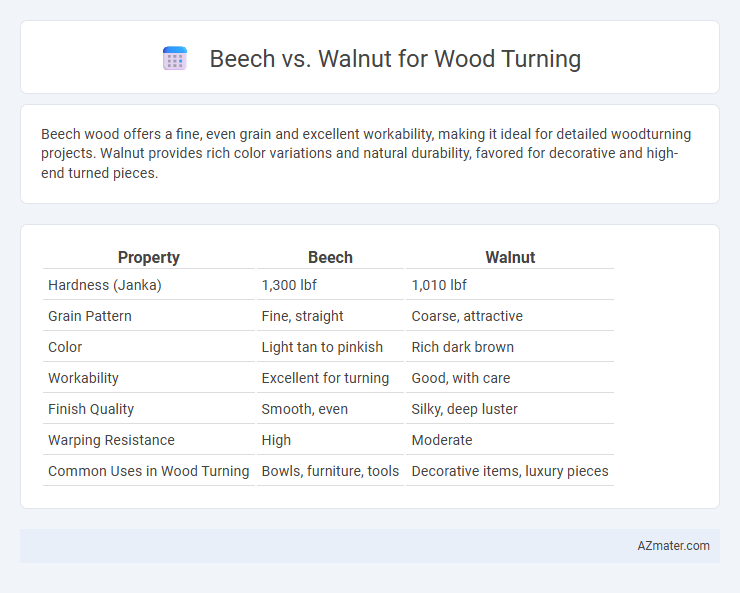Beech wood offers a fine, even grain and excellent workability, making it ideal for detailed woodturning projects. Walnut provides rich color variations and natural durability, favored for decorative and high-end turned pieces.
Table of Comparison
| Property | Beech | Walnut |
|---|---|---|
| Hardness (Janka) | 1,300 lbf | 1,010 lbf |
| Grain Pattern | Fine, straight | Coarse, attractive |
| Color | Light tan to pinkish | Rich dark brown |
| Workability | Excellent for turning | Good, with care |
| Finish Quality | Smooth, even | Silky, deep luster |
| Warping Resistance | High | Moderate |
| Common Uses in Wood Turning | Bowls, furniture, tools | Decorative items, luxury pieces |
Introduction to Beech and Walnut Wood
Beech wood is a pale, fine-grained hardwood known for its hardness, smooth texture, and excellent workability, making it a popular choice for woodturning projects that require durability and a clean finish. Walnut wood, recognized for its rich, dark brown color and striking grain patterns, offers superior stability and a luxurious appearance, favored in high-end woodturning for decorative items and fine furniture components. Both woods respond well to tools and finishes but differ significantly in aesthetics and density, influencing their suitability depending on the desired project outcome.
Physical Properties Comparison
Beech wood features a fine, tight grain with a hardness rating of 1,290 on the Janka scale, providing excellent wear resistance and ease of turning for detailed work. Walnut, with a lower Janka hardness of about 1,010, offers a smoother texture and higher natural oil content, enhancing tool glide and reducing friction during wood turning. Both woods exhibit good stability and minimal warping, but Beech's denser structure lends itself to sharper detail retention, while Walnut's workability favors projects requiring a softer finish.
Workability and Turnability
Beech wood is highly favored for wood turning due to its fine, even grain and consistent hardness, which allows for smooth cuts and detailed finishes. Walnut, known for its rich color and slightly softer texture, offers excellent turnability but can sometimes present challenges with grain tear-out if not carefully handled. Both woods respond well to sharp tools, but beech's uniform density makes it more predictable for beginners, while walnut's natural oils contribute to a smoother polish and superior final luster.
Grain Patterns and Aesthetic Appeal
Beech wood features a fine, straight grain pattern that offers a smooth, uniform appearance ideal for detailed wood turning projects, while walnut displays a richer, more complex grain with waves and curls that create striking visual depth. The light, creamy color of beech contrasts sharply with walnut's deep, chocolate-brown hues, enhancing the aesthetic appeal of finished pieces based on desired style and ambiance. Wood turners often choose beech for consistency and subtle beauty, whereas walnut is preferred for dramatic, high-end works showcasing natural grain variability.
Strength and Durability Factors
Beech wood offers excellent strength and hardness, making it highly resistant to wear and ideal for wood turning projects requiring durability. Walnut wood, while slightly softer than beech, provides superior shock resistance and a fine grain that enhances precision and detail in turned pieces. Both woods have dense structures, but beech generally outperforms walnut in long-term durability under heavy use conditions.
Finishing and Polishing Results
Beech wood offers a smooth, consistent grain that takes finishes well, resulting in a satin-like sheen ideal for fine polishing in woodturning projects. Walnut exhibits a richer, darker tone with natural oils that enhance the final polish, producing a deep, lustrous finish that highlights intricate details. Both woods respond well to sanding and buffing, but Walnut's oil content often reduces the need for additional sealers compared to Beech, which may require a primer for optimal finishing.
Cost and Availability
Beech wood is generally more affordable and widely available compared to walnut, making it a popular choice for woodturning projects on a budget. Walnut offers rich color and grain patterns but comes at a higher price point and can be harder to source, especially in large, defect-free blanks. Both woods turn well, but beech's cost-efficiency and accessibility make it ideal for beginners and high-volume work.
Ideal Wood Turning Projects for Beech
Beech wood is highly favored for wood turning projects such as kitchen utensils, bowls, and furniture components due to its fine, even grain and excellent hardness. Its resistance to wear and smooth finish make it ideal for creating detailed, durable objects like tool handles and decorative items. Compared to walnut, beech offers a more consistent texture and better shock resistance, which is essential for functional turned pieces.
Ideal Wood Turning Projects for Walnut
Walnut wood's fine grain and rich dark tones make it ideal for intricate wood turning projects such as decorative bowls, pens, and knife handles. Its durability and stability allow for smooth finishes and detailed carvings that highlight natural patterns. Unlike beech, walnut offers superior aesthetic appeal and workability for high-end, artistic wood turned pieces.
Choosing the Right Wood for Your Turning Needs
Beech offers a tight, consistent grain that is ideal for detailed wood turning projects requiring smooth finishes and durability, especially for kitchen utensils and toys. Walnut provides rich color variation and natural oils that enhance workability and result in elegant, decorative pieces with a luxurious finish suitable for bowls and vases. Selecting between beech and walnut depends on whether the priority is fine detail and strength or aesthetic appeal and natural polish in wood turning.

Infographic: Beech vs Walnut for Wood Turning
 azmater.com
azmater.com